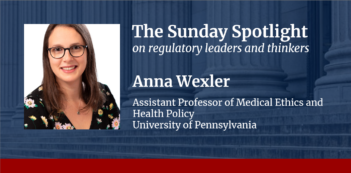
Scholar argues U.S.-China trade agreements fill regulatory gaps left by both countries.
An estimated 300,000 Chinese infants became ill in 2008 after being fed milk powder that was contaminated with melamine, a toxic compound. The contamination resulted in Chinese dairy products being recalled globally, children developing kidney stones, infants dying, defendants being sentenced to life in prison, and two men being sentenced to death for endangering the public. Despite this, a year later, melamine was once again found in milk in China.
As Ching-Fu Lin, a professor at National Tsing Hua University, explains, “For more than a decade, China has earned a reputation as one of the world’s worst food-safety offenders.”
In his recent article in the Food and Drug Law Journal, Lin argues that the Chinese food regulation scheme is ineffective, and that its deficiencies can have significant effects outside its borders. Lin looks to the U.S.-China Food Safety Agreement and changes to the U.S. Food and Drug Administration’s (FDA) practices as potential remedies for the shortcomings of the Chinese food regulation scheme, arguing that they allow for more international oversight to supplement China’s national regulatory safeguards.
“China’s food safety problem is extremely complex,” Lin writes, “because it intertwines with China’s regulatory design, political institutions, food industry structure and development, rule of law deficit, and corruption problems, to name a few.” Lin argues that China’s food industry is actually highly regulated, pointing out that China has more than 3,000 regulations regarding food standards alone. Meanwhile, in the United States, there are over 3,000 state and local agencies that regulate food industries.
Ineffective enforcement rather than ineffective law, Lin argues, is the shortcoming of the Chinese regulatory scheme. Unlike the United States, which Lin characterizes as having a highly concentrated and integrated food industry, almost 80 percent of the food establishments in China are “cottage industries” that have no more than ten employees. Further, Lin argues there are too many agencies addressing the same problems. If there were another melamine-tainted milk case, for example, one agency would create regulations for the milk itself; two other agencies would inspect milk production; and two other agencies would regulate the milk product’s marketing.
Lin argues that, without effective enforcement mechanisms in China, trade agreements have to fill the gap and ensure safe food production by providing an economic incentive for countries to comply with the stricter regulations of their trade partners.
In many trade agreements, the country importing the international products is responsible for ensuring compliance. In a World Trade Organization (WTO) agreement on food trade, for example, importing countries bear the cost of ensuring that food meets their national standards.
This can often be ineffective, given the volume of trade. Food imported into the United States, predominantly from China, Canada, and Mexico, accounts for roughly 15 percent of the total U.S. food supply in value, totaling $76 billion. Advocacy organizations have testified before the U.S. House Committee on Foreign Affairs, indicating that they expect these imports to increase by 10 percent every year until 2020. Lin highlights that, in 2002, the FDA inspected 2.3 percent of the total food imports from China and only one percent of the 3.7 million examinations of sample products it had authority to perform at U.S. ports of entry.
In contrast with the WTO agreement, the 2007 U.S.-China Food Safety Agreement shifts the costs of compliance to the country exporting the product. The Agreement requires Chinese food producers that wish to export to the United States to register with the State General Administration of Quality Supervision, Inspection and Quarantine (General Administration). In order to join the General Administration, the producer must first satisfy all FDA requirements. The General Administration is then responsible for ensuring that all registered facilities are informed of changes to FDA rules.
Under the Agreement, the exporting country also becomes responsible for informing other countries of possible foodborne hazards or other health issues with their food. It even requires that the country notify the trade partner of any hazards associated with the exported product within two days of learning about the issue. The FDA may also conduct on-site inspections of Chinese food producers without having to provide any prior notice. The FDA could then disqualify producers from exporting their goods if they find that they violate FDA production regulations. In order to conduct these on-site inspections, the FDA established offices in Beijing, Guangzhou, and Shanghai.
Lin argues that this agreement has acted as a model of international trade regulation practices. In fact, the positive experience with the Agreement has led to changes in the FDA’s trade policies. President Obama signed the Food Safety Modernization Act into law in 2011. The law builds on the experience from the U.S.-China Agreement, requiring the FDA to partner with exporting countries with the expressed goal of “expanding the technical, scientific, and regulatory food safety capacity of foreign governments… which export to the United States.”
The law also adopted the on-site inspections from the U.S.-China Agreement. The FDA may conduct inspections of foreign food producers and deny importation of their products if the producers refuse. The FDA may establish more satellite offices in foreign countries to engage in on-site inspections and provide the kind of technical assistance pursued by the law’s first goal. Lastly, the FDA may require that foreign food producers meet health standards that are equivalent to those used in the United States, requiring certifications issued by third-party accreditors.
To date, the U.S.-China Agreement remains in force, as the FDA and the General Administration extended it for an additional five years in 2012.



